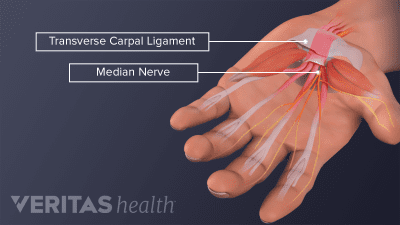A common cause of wrist and hand pain is De Quervain’s Tenosynovitis. This is essentially inflammation and irritation of the extensor tendons of the thumb at the wrist. Typically, a patient will come in who is doing some type of repetitive motion at work, whether they’re holding machinery and gripping that during the day, for a long part of the day, or doing some type of repetitive motion throughout the day, also using increased grip.
In addition to repetitive overuse injury, De Quervain’s also can occur in pregnancy. It can also have one hereditary component and can occur in diseases that are systemic, such as rheumatoid arthritis or lupus.
A patient will typically complain of pain along the outside of the wrist. There can sometimes be some numbness and tingling that might radiate to the upper part of the forearm, but typically not proximal to that.
Some symptoms that patients can have with De Quervain’s are pain on the outside of the wrist, there may be some swelling, too, that reflects the inflammation of the tendon underneath. They may have numbness and tingling along that area. They may sometimes also complain that the thumb catches or locks in certain positions.
To diagnose De Quervain’s Tenosynovitis after doing the normal neurological exam of looking at the, testing the muscle strength, the sensation, the reflexes, and ruling out other causes of hand and wrist pain, one provocative maneuver is called the Finkelstein test, which basically involves the thumb, placing the thumb inside the palm and flexing downward. Typically this motion is very painful.
Following diagnosis, the most specific way of treating De Quervain’s Tenosynovitis is to put a little bit medication as an injection, more specifically steroid and lidocaine, injecting the lidocaine and steroid under ultrasound right into the area surrounding the extensor tendons. This will reduce the inflammation and swelling around the tendon and typically will relieve the pain. In addition to the injection, sometimes a thumb splint, it’s called a spica splint, also will help keep the wrist in a neutral position and reduce the likelihood of getting into positions that put increased pressure on the tendons there.
For treating De Quervain’s Tenosynovitis, physical therapy is also essential to strengthen the muscles of the hand and the wrist to prevent pressure from being placed on the tendons. It’s also important to do an ergonomic evaluation of the patient’s workplace, so to identify the type of activity that might be instigating the tendinitis, to modify that as well as possible. Because if this is not addressed, it’s likely that the symptoms can later recur.
If physical therapy, injections, and, at times, oral anti-inflammatory medications are insufficient to treat the tendinitis, in recalcitrant cases, surgery can be recommended. And the purpose of the surgery is to open up the tendon sheath and relieve the pressure on the tendon.
Recommended for You








